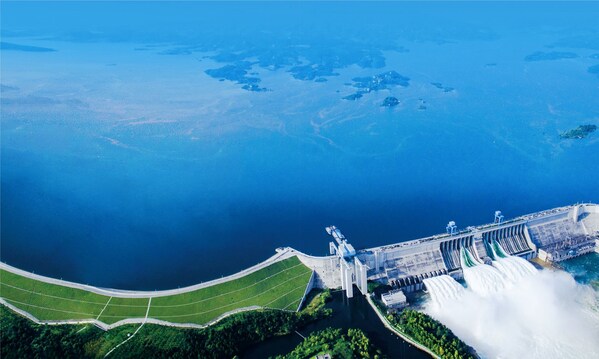BEIJING, Oct. 1, 2024 /PRNewswire/ -- A report from China Daily

The central route of the South-to-North Water Diversion Project has successfully redirected over 66 billion cubic meters of water to northern China over the last decade
On Dec 12, 2014, the South-to-North Water Diversion Project's central route, which is designed to transport water from Danjiangkou Reservoir in Southern China to the arid northern regions including Beijing through separate channels, began operation.
Over the past 10 years, the project has benefited more than 100 million people by providing them with quality drinking water. Many areas have bid farewell to the history of consuming high-fluoride or salty water.
Today, two out of every three cups of water in Beijing come from the Danjiangkou Reservoir.
The water from the Danjiangkou Reservoir has also helped alleviate water shortages in Northern China. The shallow groundwater levels in many areas have risen by at least 1 meter. Additionally, ecosystems around lakes and rivers like Baiyangdian Lake and the Hutuo River have been restored.
With the water supply, many key national strategies, including the coordinated development of the Beijing-Tianjin-Hebei region, the construction of Xiong'an New Area and the ecological protection and high-quality development in the Yellow River Basin, are guaranteed.
Long-term blueprint
The South-to-North Water Diversion Project, initially discussed by China's leaders in 1952, aimed to divert fresh water from the Hanjiang River in southern China to the drier and more industrialized northern regions.
In 1958, the construction of the Danjiangkou Reservoir commenced, with approximately 100,000 people participating in the project. From then on, regardless of how the domestic and international situations changed, regardless of the challenges and difficulties encountered, the steps to turn the dream into reality never stopped.
"At the very beginning, the command center was set up on a sand dredging boat, with all people involved sleeping on the riverbank. It was only later that oilcloth tents were provided," said Zhang Rui, deputy director of Social Education Department at Shi Yan Museum.
In 1967, the Dajiangkou Reservoir began to store water. In 1974, the construction of the first phase of Danjiangkou Reservoir was completed.
On July 22, 1980, China's leader visited the Danjiangkou Reservoir. Since then, research on transferring water from the Danjiangkou Reservoir to Northern China has advanced in tandem with China's reform and opening-up policies.
In 2002, the South-to-North Water Diversion Project overall plan was released, outlining three routes: eastern, central and western. The scale, scope and population coverage of this project were unprecedented in history.
On Dec 12, 2014, the central route project commenced operation. This route interconnects the Yangtze, Yellow and Haihe rivers.
In the last 10 years, the central route has diverted more than 66 billion cubic meters of water to northern China, nearly one and a half times the water storage capacity of the Three Gorges Dam.
Today, China has become the second-largest economy in the world. The great rejuvenation of the Chinese nation has entered an irreversible historical process.
"The original intention and mission of seeking happiness for the Chinese people and rejuvenation for the Chinese nation have determined that the South-to-North Water Diversion project must be carried out to the end," said Ye Xueping, director at the Institute of Economics under Hubei Academy of Social Sciences.
Harmony with nature
The reshaping of landscapes did not lead to ecological degradation. On the contrary, it has fostered a harmonious coexistence between humans and nature.
The Danjiangkou Reservoir needs to divert water from the upper reaches of the Hanjiang River to northern China. Therefore a canal project, aimed at transferring water from the Yangtze River to the Hanjiang River, has commenced construction to secure water supply in the middle and lower reaches of the Hanjiang River.
The nationwide unified scheduling serves as a cohesive strategy, guaranteeing a consistent water transfer volume to the north while tackling decreased water levels in the middle and lower reaches of the Han River following water diversion.
In the past 10 years, Shiyan city has invested more than 30 billion yuan ($4.27 billion) in water quality management, treatment and protection.
In 2023, the Danjiangkou Reservoir Water Quality Security Command Center was established in Shiyan City to leverage new technologies like satellite monitoring and drone patrols for water quality management.
Starting from the Danjiangkou Reservoir, it takes 15 days for the water to reach Beijing. Along the way, 26 large and medium-sized cities that receive this water have implemented various measures to protect water resources.
Some have constructed ecological protection projects along the canal to establish ecological corridors; others have enacted control measures for preventing and treating groundwater pollution, while some have undertaken the restoration of domestic river sections, transforming desolate shores into thriving wetlands.
Working toward the same goal
Since the commencement of dam construction, many residents along the route have been relocated, with some enduring two large-scale migrations.
Wang Ruiquan, a villager who ran two factories in Mawancun Village, underwent two migrations in 1965 and 2005. In 2005, he was the first to agree to the relocation plan.
"It's a national priority project, so it must not be influenced by any single individual like me," said Wang.
In gratitude to the former residents of the reservoir area, 10 districts of Beijing have established a long-term cooperation relationship with Shiyan city. Over the past decade, Beijing has allocated a total of 2.25 billion yuan in aid for Shiyan. A total of 54 Beijing-based enterprises have established operations in Shiyan.
Nine neighboring cities of Shiyan, including Wuhan, Huanggang and Qianjiang, offered favorable land and policies to migrants to support them in rebuilding their homes.
Over the last 10 years, people in Hubei province and Shiyan attached significant importance on water protection. A total of 250 voluntary water protection and conservation groups have been established.
In the future, the dam on the Hanjiang River will continue to play a key role in protecting the descendants of the Chinese nation.






